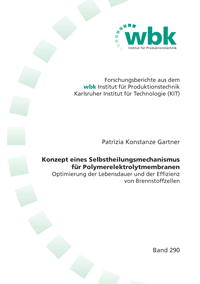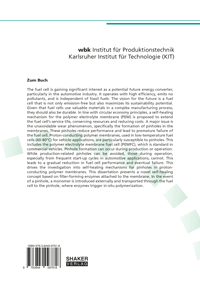
Shop : Details
Shop
Details
59,80 €ISBN 978-3-8440-9781-8Softcover264 pages61 figures348 g21 x 14,8 cmGermanThesis
February 2025
Patrizia Konstanze Gartner
Konzept eines Selbstheilungsmechanismus für Polymerelektrolytmembranen
Optimierung der Lebensdauer und der Effizienz von Brennstoffzellen
The fuel cell is gaining significant interest as a potential future energy converter, particularly in the automotive industry. It operates with high efficiency, emits no pollutants, and is independent of fossil fuels. The vision for the future is a fuel cell that is not only emission-free but also maximizes its sustainability potential. Given that fuel cells use valuable materials in a complex manufacturing process, they should also be durable. In line with circular economy principles, a self-healing mechanism for the polymer electrolyte membrane (PEM) is proposed to extend the fuel cell's service life, conserving resources and reducing costs. A major issue is the unavoidable wear phenomenon, specifically the formation of pinholes in the membranes. These pinholes reduce performance and lead to premature failure of the fuel cell. Proton-conducting polymer membranes, used in low-temperature fuel cells (60-80°C) for vehicle applications, are particularly susceptible to pinholes. This includes the polymer electrolyte membrane fuel cell (PEMFC), which is standard in commercial vehicles. Pinhole formation can occur during production or operation. While production-related pinholes can be avoided, those during operation, especially from frequent start-up cycles in automotive applications, cannot. This leads to a gradual reduction in fuel cell performance and eventual failure. This drives the investigation into self-healing mechanisms for pinholes in proton-conducting polymer membranes. This dissertation presents a novel self-healing concept based on filler-forming enzymes attached to the membrane. In the event of a pinhole, a monomer is introduced externally and transported through the fuel cell to the pinhole, where enzymes trigger in-situ polymerization.
Keywords: Brennstoffzelle; Polymerelektrolytmembran; PEM; Selbstheilung; Lebensdauer
Forschungsberichte aus dem wbk, Institut für Produktionstechnik, Karlsruher Institut für Technologie (KIT)
Edited by Prof. Dr.-Ing. Jürgen Fleischer, Prof. Dr.-Ing. Gisela Lanza and Prof. Dr.-Ing. habil. Volker Schulze, Karlsruhe
Volume 290
Other formats
Electronic publication (PDF): 978-3-8440-9876-1
Export of bibliographic data
Shaker Verlag GmbH
Am Langen Graben 15a
52353 Düren
Germany
Am Langen Graben 15a
52353 Düren
Germany
Mon. - Thurs. 8:00 a.m. to 4:00 p.m.
Fri. 8:00 a.m. to 3:00 p.m.
Fri. 8:00 a.m. to 3:00 p.m.
Contact us. We will be happy to help you.



